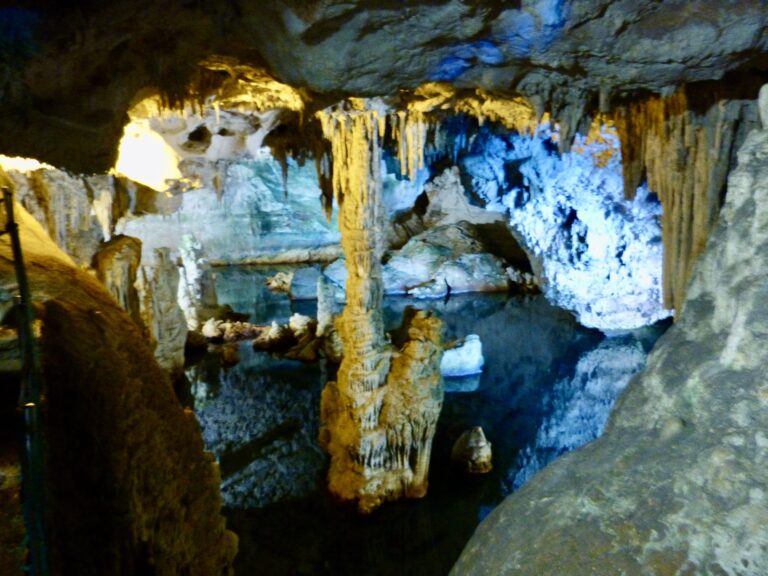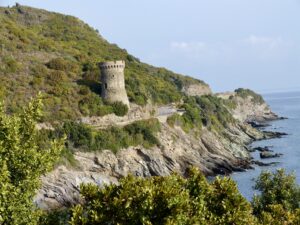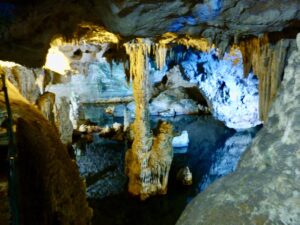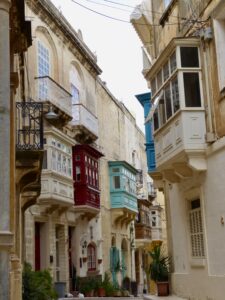
In September 2019 I booked a group tour of Malta, Sicily, Sardinia and Corsica for May 2020. After three postponements due to Covid, I finally embarked on the tour in September this year. Space has limited this report to what I regard as its highlights.
All four islands have a similar, complicated history, over many centuries, of occupation by a succession of different powers, which has led to a fascinating variety of architecture.
I flew via Dubai to Malta, where I joined our tour leader and the other 20 members of the group. I loved Malta, especially its narrow streets overhung by colourful enclosed balconies, and was sorry that we spent only two full days there, especially as rain in the afternoon of the first made photography a challenge. When I first booked the tour, it included a third day, visiting the Island of Gozo; but that was removed from the itinerary following the collapse, in a storm, of the ‘Azure Window’, a unique rock formation considered to be the prime attraction of the island. By way of compensation, we received a pleasant surprise when a fleet of white vintage cars, including a Rolls Royce, arrived at our hotel to take us to dinner.

We then took an early morning ferry to the Sicilian port of Pozzallo. I’d visited Sicily before, in 1995, when Allan and I drove ourselves around the island, but I was happy to see the highlights again, and several places we’d missed when travelling alone. From Taormina, a picturesque resort, we were driven in 4WD vehicles to the base of Mount Etna. In 1995 Allan and I had walked to the crater, with embers glowing either side of a narrow path; but this time our group followed a safer, albeit very steep, path, to a viewpoint well beneath the summit.
From Taormina we drove to the town of Piazza Amerina, to visit the Villa Romana del Casale, home to some of the best-preserved and extensive examples of Roman mosaics in the world. Fortunately the villa is under cover, as torrential rain had prompted me to buy a poncho in the carpark – a purchase unneeded for the rest of the tour, blessed with near perfect weather. Next came Agrigento, and the Valley of the Temples – a World Heritage-listed complex of well-preserved Doric temples dating back to the 5th and 6th centuries BC.
Poor signage to the winery substituted for that in our itinerary delayed our arrival; but it was beautiful, and our lunch there was well worth the wait. We then drove to Palermo, the island’s capital, from which we visited Monreale, for its 12th century cathedral housing magnificent mosaics, and the mountain-top, medieval town of Erice – which we had to reach by coach, as strong winds had stopped the operation of the cable car..
In Palermo we were entertained by the second surprise of the tour – a private puppet show where all the puppeteers were members of the third generation of the same family

I’ve always liked boats, and the tour did include some scenic boat trips, with me usually in the bow. But I was disappointed that our planned overnight ferry from Sicily to Sardinia was replaced by a flight. We started in Cagliari, with archeological remains, churches (I was starting to get blasé about the stunning interiors of the many churches we visited) and museums. But a short drive from the city centre took us to a highlight of the island – a wildlife reserve whose lagoons are home to a vast colony of flamingos, the only ones in the world which don’t migrate.

Next we explored the island’s largest Nuraghe – an amazing structure, once more than three stories high, built nearly 3,500 years ago but rediscovered only in 1949. The village of Orgosolo, despite being inhabited since prehistoric times, provided a more modern attraction, in the form of 150+ murals – including a group of women painted around an ATM on the Bank of Sardinia. After walking through the village we lunched in a forest, on boar roasted on a spit – a meal so “fulsome” (as described in our itinerary) that no dinner was included that day.
In the very different, but equally picturesque medieval city of Alghero (where the residents speak Catalan, not Italian), we learnt how its unique blood-red coral is recovered from the depths, and then fashioned into jewellery, before taking a boat to explore the undergound Grotta di Nettuno, 2,500 metres long – the most stunningly beautiful cave I’ve ever seen. From Alghero we drove to the small port of Palau, at the most northern point of the island, from which we took another boat to the Island of La Maddelena, and the following day we boarded the ferry to Corsica.

Sailing into the beautiful natural harbour of Bonifacio, with medieval houses perched precariously on the edge of towering cliffs, I was quickly convinced that our itinerary had left the best until last. There we toured the steep streets of the old town by “train”, which looked as if it had escaped from an amusement park.
Our next stop was Ajaccio, capital of Corsica. Napoleon was born there, and he’s in evidence everywhere. Our visit to his house fell within a strict time-frame, as it’s such a popular tourist destination. But for me the scenery was a far greater attraction. I can do no better than quote from our itinerary: “In an island of such extraordinary natural beauty as Corsica, it is difficult to suggest one which contains the most sublime scenery on the island. Yet the Gulf of Porto lays claim to this title. Here stacked slabs of red granite, towering pinnacles and gnarled, claw-like outcrops of rock were formed by volcanic eruptions 250 million years ago and subsequent erosion has fashioned spectacular shapes in the rock, The colours are remarkable and vary from charcoal-grey to incandescent reds and rusty purples which strike a vivid contrast with the deep green maquis” [I had to google it] “and the cobalt-blue sea.” We saw it all by boat, and my only regret is that, owing to an unprecedented problem with my camera, all my photos of it turned out blue.
On the drive to Bastia, our final destination, and from there a tour of Cap Corse, a finger of land that juts from the northern tip of Corsica, we saw yet more dramatic scenery, both mountain and coastal, and quaint fishing villages with their historic ‘Genoese’ towers. From Bastia we flew to Nice to connect with our flights home.

Souvenir collectors may have been somewhat disappointed.since, apart from the ceramics of Sicily and coral jewellery of Sardinia, most tourist shops sold the same, cheap items, probably made in China. Happily, our memories and photos provided the best souvenirs of a memorable holiday.
In BC (before Covid) times, the Voice published a series of articles, “Travellers’ Tales”, in which KV residents wrote of their travel experiences, both in Australia and overseas. I hope that this article may prompt a revival of that series.
Tony Barnett